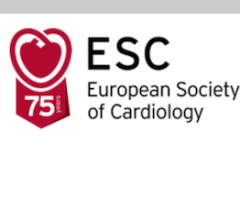
The STELLAR Phase III Trial findings were unveiled on the final day of the American College of Cardiology Scientific Session, ACC23/WCC, by lead author Marius M. Hoeper, MD, Deputy Director of the Department of Respiratory Medicine at Hannover Medical School in Hannover, Germany. Research found that adding a novel first-in-class medication in combination with background therapy led to significant improvements in walking distance for patients with pulmonary arterial hypertension (PAH), a severe, progressive condition that affects the heart and lungs. Photo courtesy of ACC.
March 6, 2023 — In findings presented from the STELLAR Phase III Trial during the American College of Cardiology’s 2023 Scientific Session, ACC23/WCC, researchers reported that adding a novel first-in-class medication in combination with background therapy led to significant improvements in walking distance for patients with pulmonary arterial hypertension (PAH), a severe, progressive condition that affects the heart and lungs.
Researchers found that patients who were treated with the novel first-in-class medication Sotatercept on top of existing therapy experienced significant improvements in walking distance via a six-minute walking test — the study’s primary endpoint and a validated surrogate for functional improvement and reduced symptom burden. Additionally, participants who received Sotatercept also had an 84% lower risk of death or worsening of their condition compared with patients on standard therapy.
The “STELLAR Phase III Trial: A Study of Sotatercept in Combination with Background Therapy for The Treatment of Pulmonary Arterial Hypertension” was presented on the final day of ACC23 Together with WCC, and was simultaneously published online in the New England Journal of Medicine (NEJM).
“These results establish the clinical utility of Sotatercept as a new approach to the treatment of PAH in combination with existing approved therapies,” said the study’s lead author, Marius M. Hoeper, MD, Deputy Director of the Department of Respiratory Medicine, also in charge of the pulmonary hypertension (PH) program, at Hannover Medical School in Hannover, Germany. He added, “It’s really a paradigm shift in how we will treat PAH in the future.”
Globally, more than 10 medications are approved to treat PAH. However, many patients continue to have severe symptoms despite treatment with as many as three medications. The disease can progress rapidly and median survival after diagnosis is about seven years with current therapies, underscoring the need to develop novel therapies, Hoeper said. Sotatercept, a first-in-class activin signaling inhibitor, works by blocking abnormal signaling between cells in the pulmonary blood vessels, which may lead to a partial reversal of the disease process.
The Phase 3 STELLAR trial enrolled 323 patients (median age 48 years, 79% women) with PAH in 20 countries. At enrollment, 60% of the patients had severe symptoms despite maximal therapy with three medications. Many patients had shortness of breath so severe that minimal activity such as taking a few steps or climbing a flight of stairs left them breathless. On average, patients had been living with PAH for almost nine years before enrolling in the trial.
Patients were randomly assigned to receive either Sotatercept or a placebo, given as a subcutaneous injection (under the skin) once every three weeks, in addition to their other PAH medications. The trial was double-blinded, meaning that neither patients nor their doctors knew who was receiving Sotatercept or the placebo until the trial was over. Patients were followed for a median of 7.5 months.
The trial’s primary endpoint was the change in the distance patients could walk in six minutes (known as the six-minute walk distance or 6MWD) at 24 weeks. The average improvement in 6MWD among patients receiving Sotatercept was 40.8 meters (134.5 feet, about a half of a typical city block), while patients who received the placebo showed no improvement. The change was statistically significant and exceeded the minimum of 33 meters (about 108 feet) that, according to earlier research, patients experienced as a noticeable improvement in their walking capacity, Hoeper said.
The study had nine secondary endpoints. Eight of the secondary endpoints were met, including functional class—a measure of impairment due to the disease; proBNP levels, which reflect cardiac strain; and several measures of quality of life. Time to death or the first occurrence of a “clinical worsening” event (defined as a combination of death from any cause, deterioration of exercise capacity or hospitalization for PAH) measured at study completion in August 2022 showed a significant advantage in the Sotatercept group.
Nine patients (5.5%) in the Sotatercept group died or experienced at least one clinical worsening event, compared with 42 (26.3%) in the placebo group, a risk reduction of 84%. Scores on a validated scale of PAH symptoms showed that patients on Sotatercept had statistically significant improvements in symptoms such as shortness of breath and fatigue, as well as in the ability to perform activities such as light household chores, whereas patients on placebo showed no improvements. Scores for cognitive and emotional impacts such as thinking clearly and feeling sad or worried were not significantly different between the two groups.
In addition, the Sotatercept group saw a reduction in pulmonary arterial pressure, or blood pressure in the lungs, that was 13.9 mmHg larger than was seen in the placebo group.
“This is the most impressive reduction in the pulmonary arterial pressure that we’ve ever seen in pretreated patients with PAH,” Hoeper said. “For me, it’s one of the strongest signals suggesting that we truly achieved some regression of the disease’s adverse changes in the pulmonary vessels. However, this remains a hypothesis that we need to explore in future studies.”
Overall, the drug was safe and well tolerated. Mild nose bleeds and bleeding of the gums were the most common adverse effects among patients taking Sotatercept. More patients on Sotatercept also had noticeable dilation, or widening, of the capillaries, called telangiectasias, which appear as red dots on the skin, mostly on the chest and face. Other adverse effects were increases in hemoglobin levels and lower platelet counts. Platelets are blood cells that help the blood to clot, so a reduction in platelets could leave patients vulnerable to bleeding episodes. These adverse effects were not severe among patients enrolled in the trial, Hoeper said, adding that longer follow-up is needed to assess adverse effects over time.
“With any medication that patients can be expected to take, perhaps for a lifetime, such adverse effects need to be monitored closely,” Hoeper said. “Still, what we see in our clinic is fascinating—patients who have been evaluated for lung transplantations coming off the transplant list, patients returning to work, young patients who have been ill for most of their lives starting at their first jobs. [This treatment] opens the door to further research aiming at restoration of a normal pulmonary blood flow.”
Most trial participants are now enrolled in a long-term extension study of safety and efficacy in which everyone, including those originally assigned to the placebo group, is being treated with Sotatercept. In addition, ongoing phase 3 trials are investigating Sotatercept in patients with newly diagnosed PAH and in patients with even more severe PAH than those in the STELLAR trial. The study was funded by Acceleron Pharma Inc., a wholly owned subsidiary of Merck Sharp & Dohme, a subsidiary of Merck & Co. Inc.
“A Landmark Trial in the Field”
In the panel discussion that followed the presentation of findings, the significance of the research was credited by interventional cardiologist Jane Leopold, MD, director of the Women's Interventional Cardiology Health Initiative at Brigham and Women’s Hospital, associate professor of medicine at Harvard Medical School (Boston, MA). Leopold offered heartfelt congratulations to Hoeper and his co investigators for what she referred to as “a landmark trial in the field.” An excerpt of her comments follow:
“This is practice changing. This, as he has said, is a new drug in a field where we have not had a lot of change over quite a long time…The absolute risk reduction really may turn out to be around 20%, number needed to treat around five, which is amazing. We don't see this with any of the drugs that are available. There was an 84% risk reduction in deaths or non-fatal clinical worsening;14 millimeter drop in mean PA pressures…these are things we do not see with the drugs that we have available. To put this in perspective, these results all occurred on background therapy. This was not just given to treatment naive patients, these patients were optimally treated with state-of-the-art medications. And yet this led to major further improvements. Among the drugs that we have in the United States, there are currently 10 FDA approved drugs that we cycle between, and this now is a first-in-class drug that's going to be added to our armamentarium we hope quite soon. Just to even put this in perspective of clinical trials in the PAH field. If you go back to 2015 when the AMBITION trial came out, this was really one of the last practice changing trials that we had. And the idea there was ‘What was better? Mono therapy or combination therapy?’ And in fact, even when you gave two drugs from different classes to the patient, what we saw at that point was the change in six-minute walk distance was only 25 meters in this trial presented today, the change in walk distance on top of these drugs whereas around 40 meters, which is huge. The gains seen with this drug again also cannot be overstated. Now, as noted, this does come at a little bit of a cost and there are some side effects, but they've been identified, and they can be watched and monitored inpatient…over time with more experience, we'll come to find out how significant many of these are. Leopold addressed issues which were not yet answered, but commended the researchers, referring to the findings by saying, “It is an absolute win for the patients.”
PAH is a rare progressive condition caused by narrowing and scarring in the small blood vessels of the lungs that inhibits blood flow from the right side of the heart, which raises blood pressure in the lungs and forces the heart to work harder to pump blood through narrowed arteries. The underlying structural changes in the small pulmonary arteries are caused by imbalances between growth inhibiting and growth promoting mediators, including activins. PAH is often seen in women aged between 30 and 60 years, and about 1 in 5 patients have a family history of the disease. Diagnosis of PAH is frequently delayed because its symptoms — shortness of breath, fatigue, swelling in the feet and legs, dizziness or fainting spells, chest pain, heart palpitations — resemble those of more common heart and lung diseases.
For more information: www.acc.org


 November 17, 2025
November 17, 2025 









